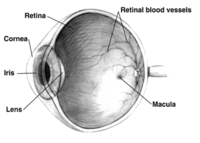
Photo from wikipedia
Aim: To investigate the association of retinal vascular changes with a risk of dementia in longitudinal population-based study. Methods: We performed a nested case-control study of 3,718 persons, aged 40–89… Click to show full abstract
Aim: To investigate the association of retinal vascular changes with a risk of dementia in longitudinal population-based study. Methods: We performed a nested case-control study of 3,718 persons, aged 40–89 years, enrolled between 1983 and 2004. Retinal vascular changes were observed in 351 cases with disabling dementia (average period before the onset, 11.2 years) and in 702 controls matched for sex, age, and baseline year. Incidence of disabling dementia was defined as individuals who received cares for disabilities including dementia-related symptoms and/or behavioral disturbance. Conditional logistic regression analysis was used to calculate odds ratio (OR) and multivariable adjusted OR (Models 1 and 2) for incidence of disabling dementia according to each retinal vascular change. Regarding confounding variables, Model 1 included overweight status, hypertension, hyperglycemia, dyslipidemia, and smoking status, whereas Model 2 also included incidence of stroke prior to disabling dementia for further analysis. Results: The proportion of cases (controls) with retinal vascular changes was 23.1 (15.7)% for generalized arteriolar narrowing, 7.7 (7.5)% for focal arteriolar narrowing, 15.7 (11.8)% for arteriovenous nicking, 10.5 (9.3)% for increased arteriolar wall reflex, and 11.4 (9.8)% for any other retinopathy. Generalized arteriolar narrowing was associated with an increased risk of disabling dementia: crude OR, 1.66 (95% confidence interval, 1.19–2.31); Model 1: OR, 1.58 (1.12–2.23); Model 2: OR, 1.48 (1.04–2.10). The number of retinal abnormalities was associated in a dose–response manner with the risk. Conclusion: Generalized arteriolar narrowing and total number of retinal abnormalities may be useful markers for identifying persons at higher risks of disabling dementia.
Journal Title: Journal of Atherosclerosis and Thrombosis
Year Published: 2017
Link to full text (if available)
Share on Social Media: Sign Up to like & get
recommendations!